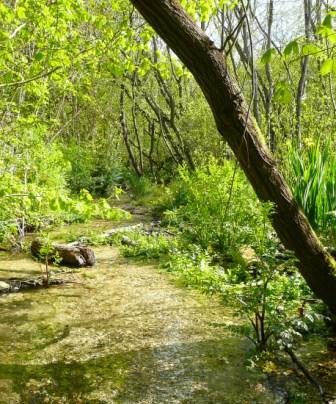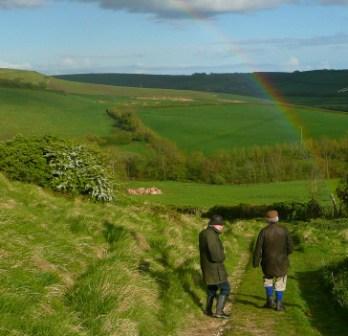|
|
The type of natural habitat largely dictates the range and type of species likely to be seen. To the North of the village we have the chalk downland which is all designated as SSSI. Coming off the hill heading South we have a mixture of arable farmland with mature hedgerows and the river Jordan flowing down from the spring basin. The land along the stream comprises of wet woodland, a water meadow and a wet meadow.
In the valley bottom we have the Osmington brook joining the Jordan before the land rises again up onto the Limestone hillsides to the South including Chalbury Fort.
|
|
The Chalk downland is particularly rich with wild flowers, butterflies and has one of the largest breeding colonies of Linnets in the county.
The habitats along the Jordan contain a very high density of breeding farmland birds; an extensive small mammal population included the protected water vole as well as a significant range of species of bats.
The sheltered valley bottom in the winter attracts very large numbers of winter thrushes and finches as well as in the summer being a dense feeding conduit for bats.
For more details, see the following pages.
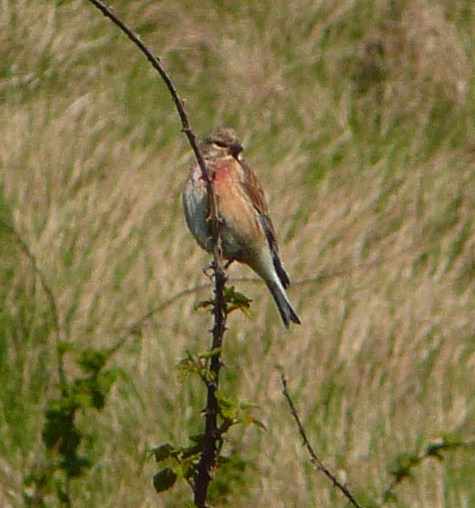 Linnet Linnet |
A varied selection of birds can be seen in and around the village, from heathland types, waterfowl, garden visitors and seabirds. We currently have records of over 80 different species and although some might be only singletons it does show the variety of bird life. With a wide range of habitats in the area, over a period of an hour or so you can typically see 20 or more species at most times of the year.
Birds are in general easy to spot and many people find their antics endearing, perhaps spending a little more time than they can afford watching them. From casually watching birds to counting them regularly is but a short step and doing so over a long period can be very revealing. Birds are dependent on their habitat for food, nesting sites, cover etc and a change in the numbers counted, up or down, not only tells us how well a particular species is doing, but also the underlying health of everything else it depends on.
The group has been counting birds in and around the village for well over 10 years, which is long enough to detect some changes. The data has been collected by means of two surveys, each carried out once a month.
One survey is a “spot” count around the Spring Basin and West Hill. The observer stands at each spot and records all the birds they can detect. If you would like to participate in this contact Dave Emery. The skill level required is quite high as you need to be able to recognise birds by sight and sound.
The other survey is our monthly garden bird watch. The level of expertise needed is lower and easily learned. There’s help on hand to get you started should you need it. This survey is proving to be very popular, and not only by those who can't get out much or don't fancy scrambling around the hill side, We now have around 20 households regularly taking part and as a reward each month a report drops into their email box showing what’s been spotted across the village plus a personal copy of John Newbould’s monthly newsletter. Contact John for more details
We have written a number of reports of surveys we have done and sent to Dorset Wildlife Trust, Natural England, RSPB, Dorset Environmental Record Centre and Wessex Water. The reports contain maps of where birds have been seen.
|
We have been recording the songs and calls of birds that you are likely to come across in the village which might help with carrying out the monthly bird surveys. These will be slowly updated as we get the opportunity to make more recordings. To get back to the web site after the recording has finished click on the reverse arrow or large black X. Great Tit: great tit song great tit call Robin; Song Tawny Owl: tawny owl call Wren: wren song Blackbird: Blackbird song
|
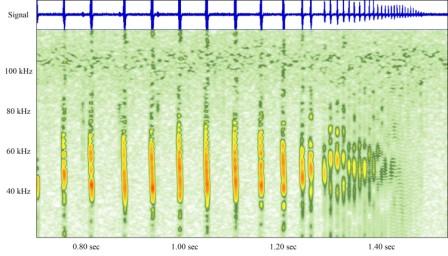 |
| Daubenton's Bat catching prey over village pond |
There are 17 species of bats that can be found in the UK with 16 of these found in Dorset and 11 been found in the village. These are Common Pipistrelle, Daubentons, Natterers, Barbastrelle, Brown Long Eared, Noctule, Serotine and Greater Horseshoe. Bats are nocturnal mammals and live in trees, buildings and caves. They have evolved over millions of years and are believed to have flown at the time of the dinosaures! Although bats are not actually blind they are much more effective at moving around and detecting their prey by echo locating their prey in flight using very high pitched sound pulses which are above the hearing range of people. However, there is technology around to help out with this in the form of bat detectors. Simple models ( costing £80 to £100 at 2024 prices ) reduce the frequency of the bat calls down by a factor of 10 into the human hearing range, they are typically the size of a mobile phone and are simply pointed in the general direction of the bat and the bat calls are played through a small loud speaker. These calls can also be recorded using a tape recorder then replayed through specialist computer software. When a bat is out hunting it sends out short sound pulses and listens for an echo from an air-borne insect. Once the bat has detected an insect it closes in causing the rate of transmitted pulses to increase. The picture on the right shows a recording we made over the village pond of a Daubenton’s bat and you can see how the sound pulses become closer together until the moth meets it’s demise in a final blur of sound. Click here to hear a recording of Common and Soprano Pipistrelles and Daubentons all flying at the same time over the pond.
Most bats use different sound pulses and are analysed on the computer to aid species identification. Some examples are shown in the other pictures.
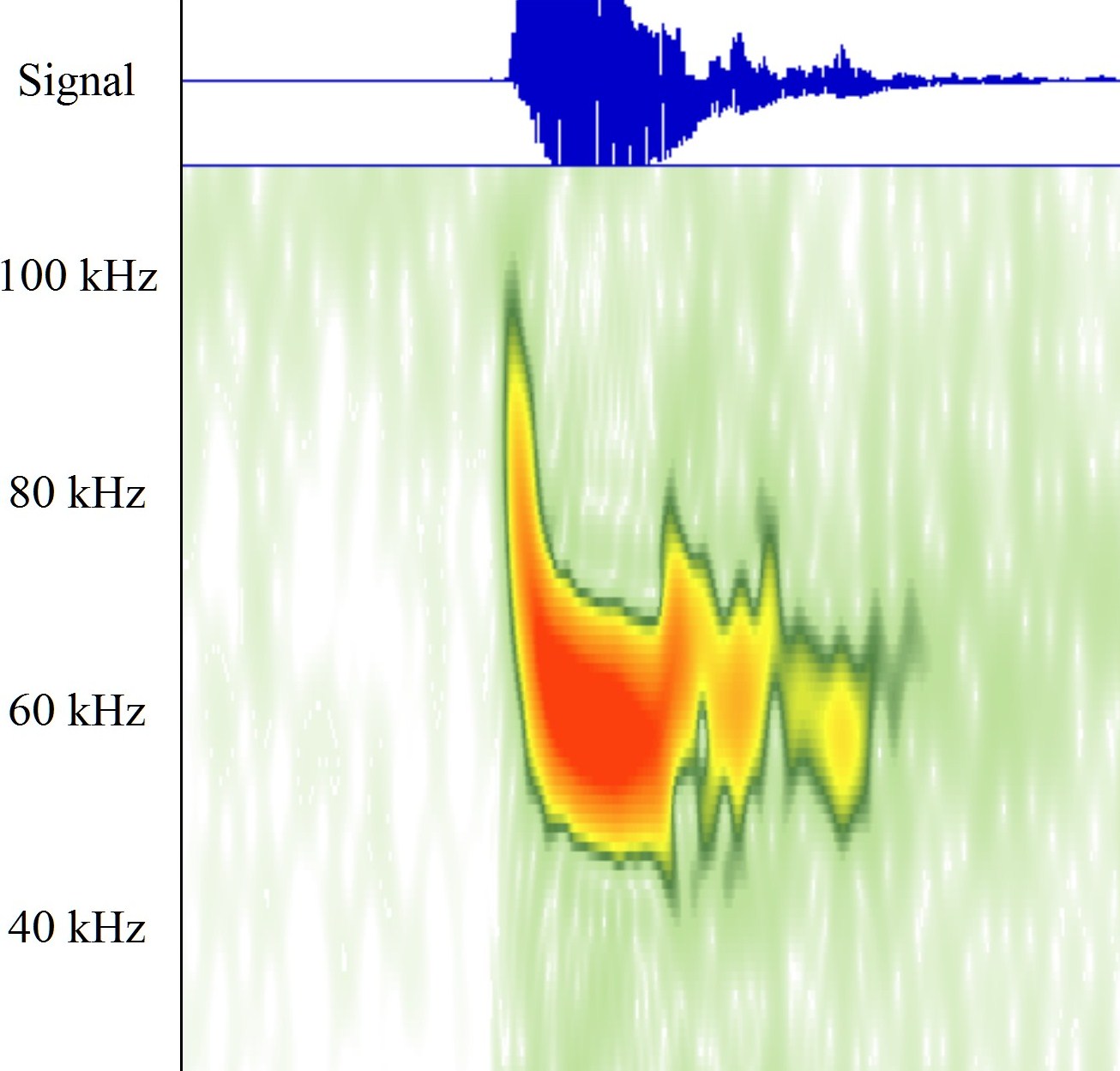 |
|
| Soprano pipistrelle |
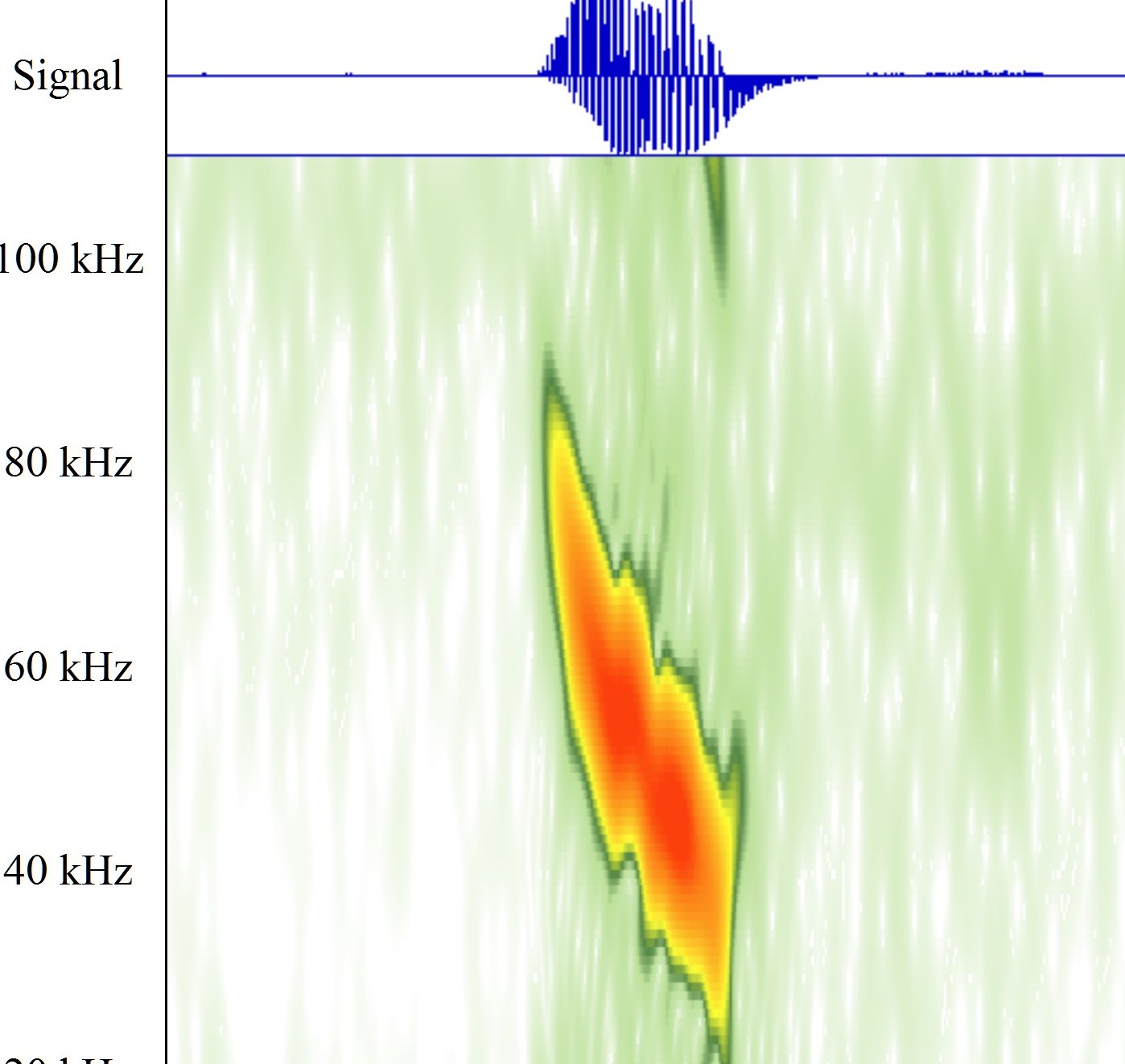 |
| Daubenton's Bat. |
The group have access to portable and fixed detectors and analysis software and has started to carry out surveys around the village. Specialists employed by Wessex Water to survey their site and we have independently completed garden surveys for vilaagers. Each summer we undertake a roost count of Common Pipistrelle bats on the Wessex Water site. and report these to the bat Conservation Trust as part of a national survey; the highest count being over 120 bats.
The equipment is easy to use and we are more than happy to lend it with some training to people in the village who would like to find out what is flying around their garden. For more information contact Dave Emery.
We had 25 species of butterfly recorded around the village last year with 19 species reported in gardens as well as the wider countryside.
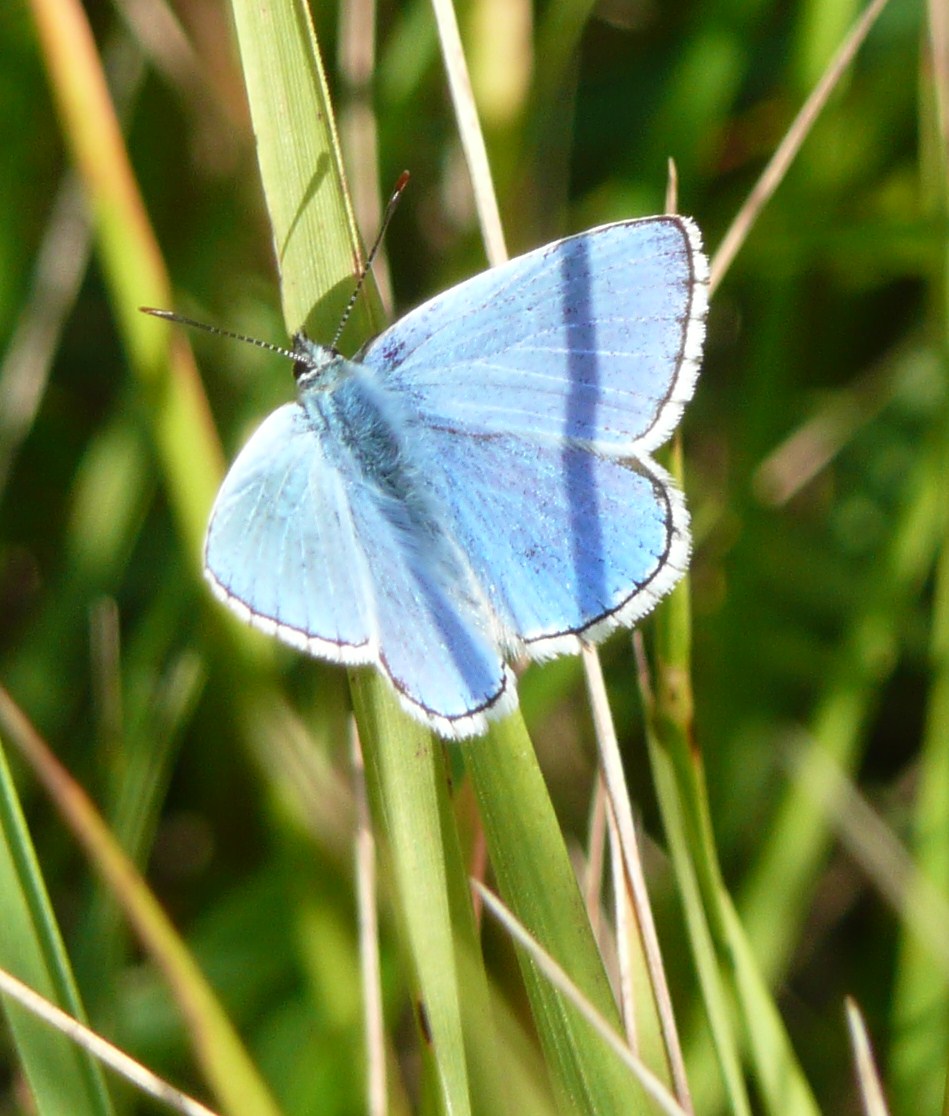 |
| Adonis Blue |
One of the best places to see butterflies are the footpaths near the bottom of the chalk down land near the spring basin particularly on a still sunny day. Butterflies only have short flight seasons which are not all at the same time of year so you can’t see every species at the same time.
The most commonly seen species are Peacock, Red Admiral, Small Tortoiseshell, Speckled Wood, Meadow Brown, Common Blue and of course the various Whites. We have a good population of the Adonis Blue which are quite a sight with their iridescent colour set against the yellow of the vetches along the footpaths. We also have a number of national quite scarce species such as Small Heath, Wall Brown and the Dingy, Grizzled and Lulworth Skippers.
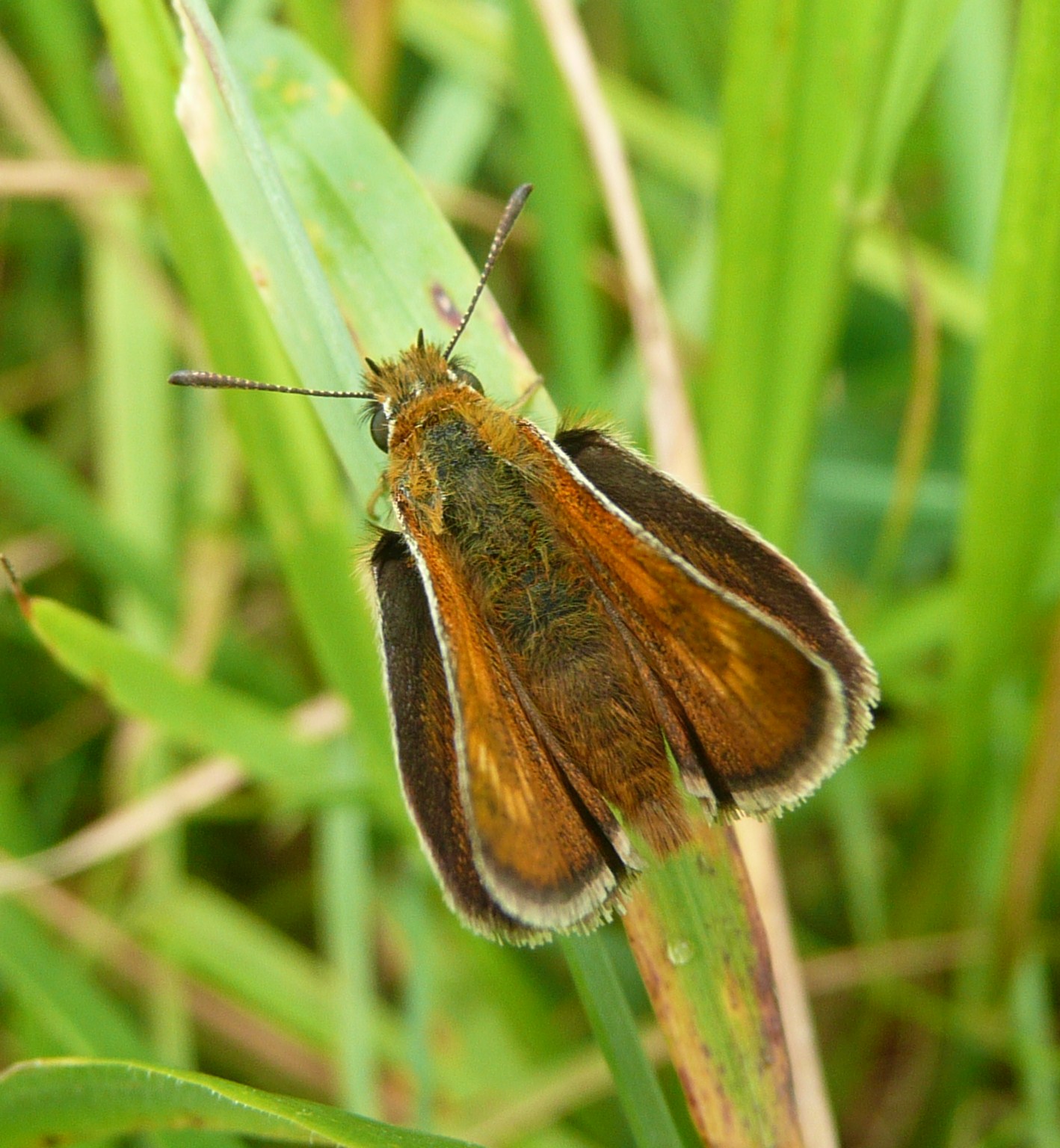 |
| Lulworth Skipper |
Skippers are not as colourful as some of the other species and are a lot smaller but if you look carefully in the bramble patches around the bottom of the downs you can usually find the more common Large and Small Skipper as well as occasionally the Lulworth Skipper. These are quite engaging little creatures as you can see from the picture opposite.
Wessex Water with Natural England are working with the Tenant Farmers to reduce the long invasive Tor-grass on the side of the down land to encourage more wild flowers. The steep sides of West Hill have been fenced to introduce a limited number of horses in an effort to graze down the long rank grass. More wild flowers will increase the number of butterflies as well as, hopefully, making the hill side more visually attractive from the village.
.jpg) |
| Black Arches Moth |
Most people regard moths as small brown uninteresting beasts that are blamed for wrecking clothes in wardrobes. There are in fact over 800 species of moth that have been recorded in the UK and many are as spectacularly coloured as butterflies. They range from the large brightly coloured Hawkmoths to quite small but delicately patterned moths not much bigger than a thumb nail. Not all moths are nocturnal and some of the more brightly coloured examples such as the red and black Six-spot Burnet are often seen on the chalk downland or the Garden Tiger Moth that many people have disturbed in their gardens.
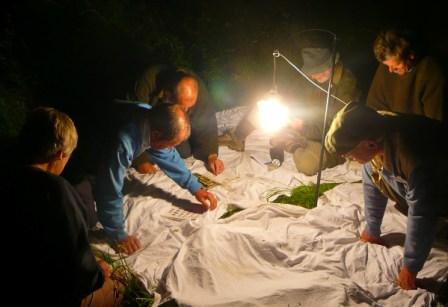 |
| Moth trapping in the water works |
The best way of seeing moths not surprisingly is to run a lamp outside at night and see what is attracted in from the surrounding area. There are specialist bulbs that give out a type of light that attracts moths.
There are broadly speaking two ways of catching moths either by running a bulb over a white sheet for an hour or so and see what comes in. John has been doing this regularly on a Friday night in the water works and those who have come along have found it good fun, particularly the children. Alternatively a number of our group have moth traps, which use the same type of light, and are left running over night and then unpacked in the morning to see what has turned up. The moths don't seem at all concerned and are released once they have been identified.
Over the last year as a group we have run traps by request in the back gardens of people in the village. Everyone has been staggered by the number and variety of species living in their gardens so if anyone is interested contact John Newbould.
Last year we recorded 250 species in the village from 1,160 records including some quite rare and some migrant species
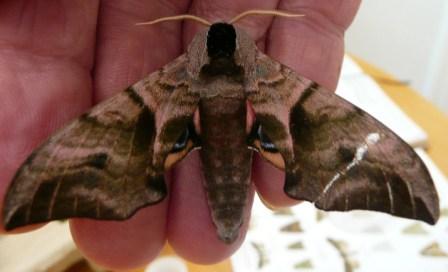 |
| Eyed Hawkmoth. |
In the Sutton Poyntz area, we are fortunate to have a number of different habitats for wildflowers. The area has a number of old orchards, where Mistletoe is present on a small number of apple trees. During August, a few lawns have flowering spikes of the diminutive scarce orchid – Autumn Ladies-tresses.
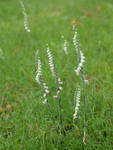 |
| Autumn Ladies Tresses © John Newbould |
With a mainly clay over chalk valley bottom, most of the wild flowers are those of neutral or west grassland. However, many of the fields are intensively managed but a few alongside the waterworks are quite herb rich with plants such as Bird’s-foot Trefoil, Bugle, Self-heal, Wild Onion, Meadow-sweet, Water Forget-me-not and Ragged Robin. A light grazing is helping these meadows to become reasonably floristically rich.
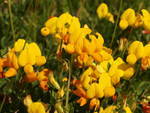 |
|
Bird’s-foot Trefoil © John Newbould. |
Sheep has grazed the steep slopes of East Hill and West Hill since the Saunders family retired from farming. Regrettably, these animals cannot cope with the Tor-grass, which has become established around the Gorse and Bramble. However, there are still small areas of chalk grassland, which have plants such as Horse-shoe Vetch (the food plant of Adonis Blue butterflies), Salad Burnet, Fairy Flax,, the occasional Pyramidal Orchid and even Early Purple-orchid. During the winter, of 2009-10 Natural England have managed to graze the area with Horses as well as reduce the Gorse mechanically. Let us hope that the grassland quality improves.
We also have a small area of woodland, to the north of the waterworks. Here under the Ash, Pedunculate Oak and Field Maple woodland the ground flora alters with the moisture levels in the wood. To the north in the wet woodland areas, King-cups are found at the streamside together with Ransoms, whilst to the south Dog’s Mercury, Early Purple Orchid, Primrose, Lesser Celandine, Pale Wood-violet cover much of the ground. There is a good shrub layer with Hawthorn, Hazel, Blackthorn, Dog Rose and Dogwood present. Most of the wood is quite recent, but the old field boundaries within the wood contain around twenty veteran trees.
The hedges in the village are of a fairly recent origin and contain Hawthorn, Hazel, Blackthorn and Elder but Holly is quite scarce. Stone walls have their own plant communities, some examples can be found here.
The River Jordan and its tributaries have a corridor of wet woodland, mainly willows but some Alder is found off Puddledock Lane. River Water-crowfoot, Yellow-flag iris and Water Speedwell are associated with the river and its banks.
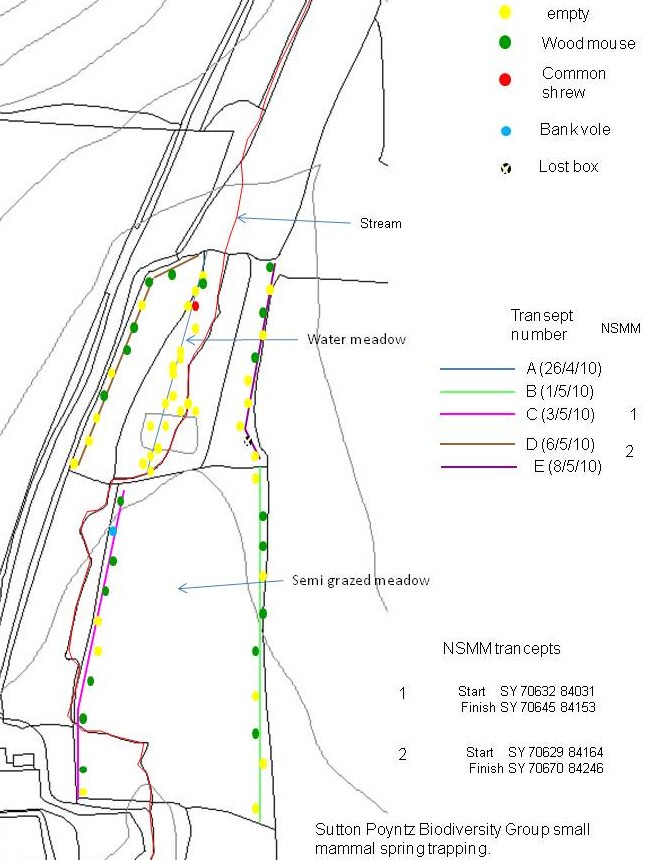 |
| Small mammal survey results. |
There are a wide range of mammals living around the surrounding countryside and no doubt in many people's houses. A number of large and small mammals have been identified using trail cameras including deer,badger,red fox polecat, mink, wood mouse and bank vole. The group carry out a monitoring programme each 6 months on Wessex water land for small mammals which involves setting humane traps ( for which we have training and a licence) along 100m lines.has signed up to a national recording scheme for small mammals which involves setting humane traps along 100m lines. Setting the traps in the evening and then seeing what has been caught the next morning, before safely releasing them, is one of the popular events we have run for children in the village. The picture on the right shows some of the results we have sent off to the national recording scheme. In the recent past we have observed water voles in the Jordan and Osmington brook. They are generally quite shy animals although sometimes they don't seem at all perturbed by people watching them.A good way of detecting them is by laying out shallow trays filled with smooth soft clay and putting them out in the evening and identifying what has run through them during the night.
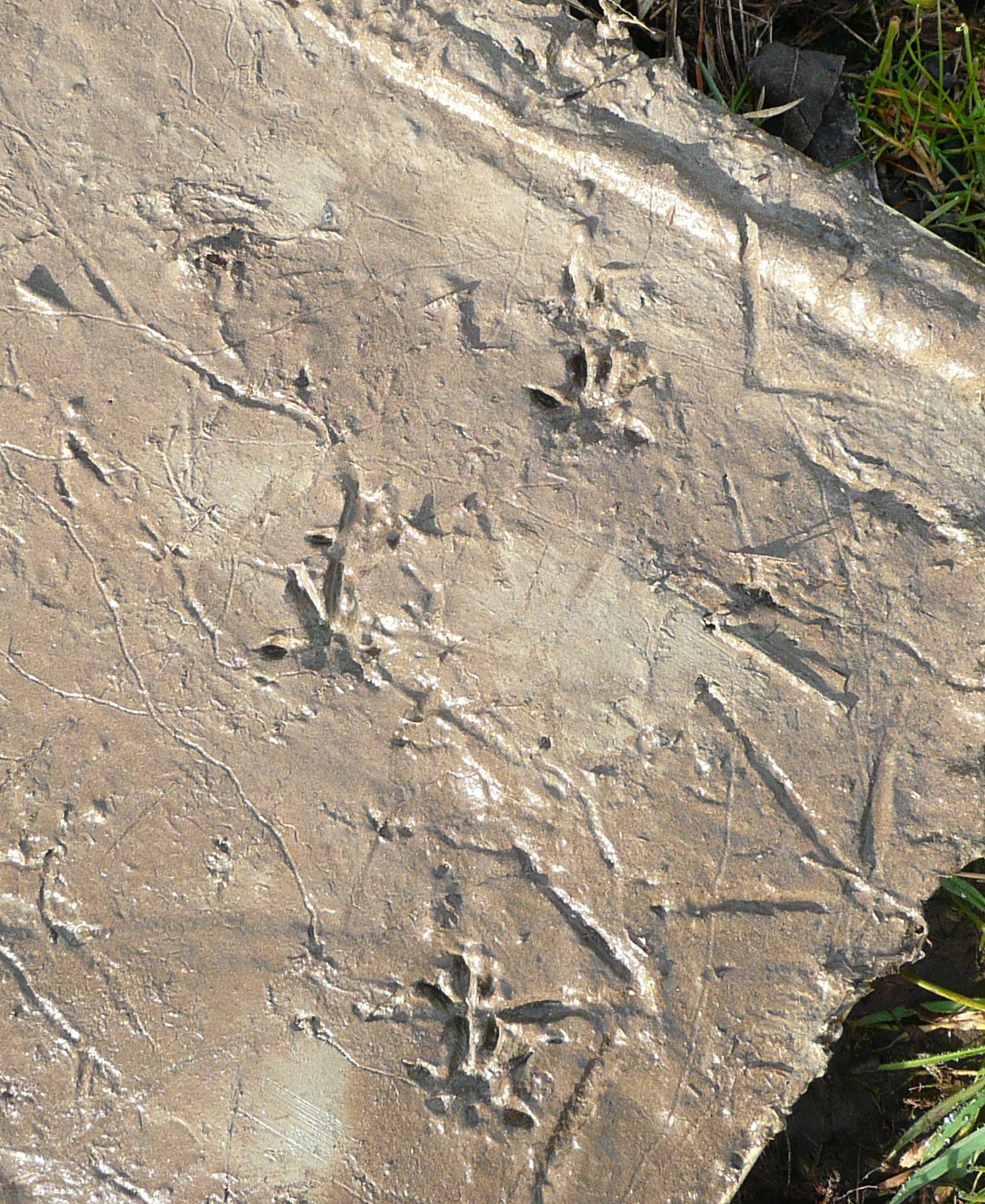 |
| Water Vole tracks. |
The picture on the left shows some Water Vole tracks from an area we didn't know had voles in.Notice how the first and fifth toes stick out almost at right angles which are quite different to all other small mammal tracks. Also in the picture you can see a track from a Heron which several villagers have seen preying on the voles.
Rabbits were once a common sight but their numbers have significantly reduced following a deadly viral infection. We haven't had any records of Brown Hare which could often been seen in the fields along the valley to Osmington. One surprise was a dead Polecat found at the top of Plaisters Lane, which is the most common way people know they are in the area. Similarily hedgehogs, dead or alive,are a rare sighting in the area these days.
We will be carrying on with our surveys so reports of any unusual sitings are all welcome and should be fed back to John Newbould. If you wish to help us with our survey work please contact Colin Marsh.
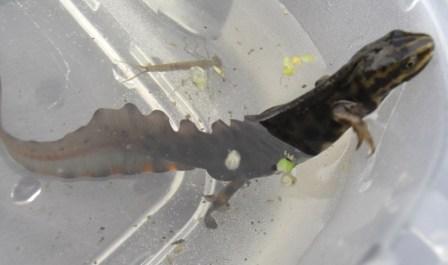 |
| Smooth Newt. © Lucy Emery. |
With its combination of mature gardens and surrounding countryside the village hosts a wide variety of amphibians and reptiles. Garden ponds are one of the best way to attract amphibians and reptiles into your garden and if you wish for any information about creating ponds please contact the group. We have a large numbers of Common toad and Common frog reported as well as good populations of Smooth Newt, shown on the right with a Stone fly nymph in the background. Frogs and newts don’t easily co-exist so ponds tend to have a predominance of one or the other. We also have records of the much rarer Palmate and Great crested newt, the later being a protected species. We are particularly keen to encourage Great crested newts which rely on having a network of ponds which they travel between for distances of up to 1 Km along suitable wildlife corridors. Unfortunately this is one area where new developments in the village can have an adverse effect. We have had many reports of slow worms around the village some of which can be up to half a metre long which often gets them mistaken for snakes.
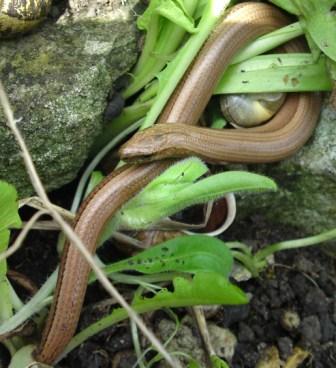 |
| Slow worm. © Lucy Emery. |
The two species of snake that are relatively common are the poisonous Adder which mainly lives on the Chalk down land and the Grass snake which occur frequently in garden compost heaps. The largest reported Grass snake was nearly a metre long and seen consuming a frog in a garden pond.
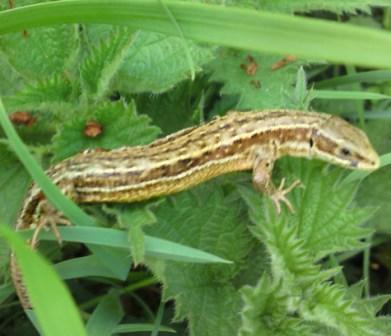 |
| Common Lizard. © Lucy Emery. |
The only species of lizard we have reports for is the Common Lizard. These can be found amongst the tussocks of long grass close to patches of scrub on the down land, but there have been some reports of them ingardens backing onto more open ground. You need a fair degree of patience to see lizards and surprisingly it is often easier to hear them before they are seen. We occasionally put out small black squares of corrugated sheeting as a survey technique to attract them, so if you see any around please leave them alone, they are all clearly marked and we do take children’s groups around to what’s underneath them.
With two streams flowing through the village we have an ideal opportunity to learn about fresh water invertebrates. What comes as quite a surprise to people is how much life exists in the completely clear and, to the naked eye, the apparently lifeless spring water running down into the village pond. To find what lives in the stream you need to master a few basic collection techniques and have good eye sight but with the use of a microscope a fascinating new world opens up.
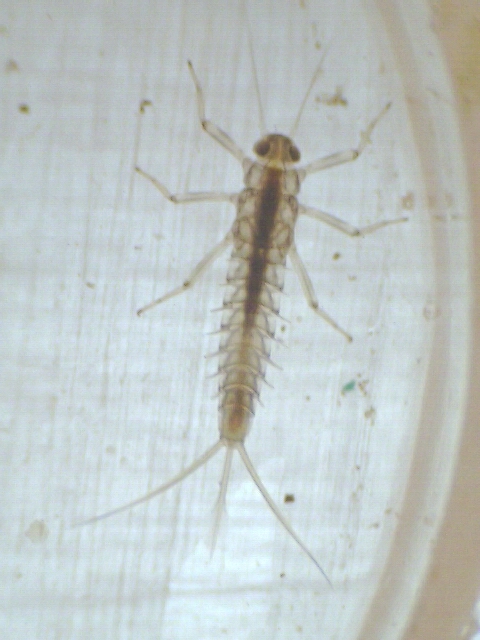 |
| Mayfly nymph. |
The group has bought all the basic survey equipment and two small digital microscopes which we have trained children in the village to use. The microscopes connect directly to a lap top computer so quite detailed pictures can be taken of creatures only a few millimetres long like the Mayfly nymph on the right. In the space of half an hour using specialised nets and the "kick and sweep" technique it is quite easy to collect 10 - 20 different species of small creature. By far the most common are the fresh water shrimps that rush around in the collecting jars but we also have large numbers of mayfly, stone fly and cadis fly larvae as well all sorts of small flat worms and beetles. You don't need any equipment to see the wide variety of cadis fly larvae that construct protective shells from small stones or vegetation. Most medium stones if picked up and turned over will have some of these shells attached like the picture on the left. If you look carefully you can see the slightly disgruntled occupant looking out of the open end. But please put them back exactly where you found them.
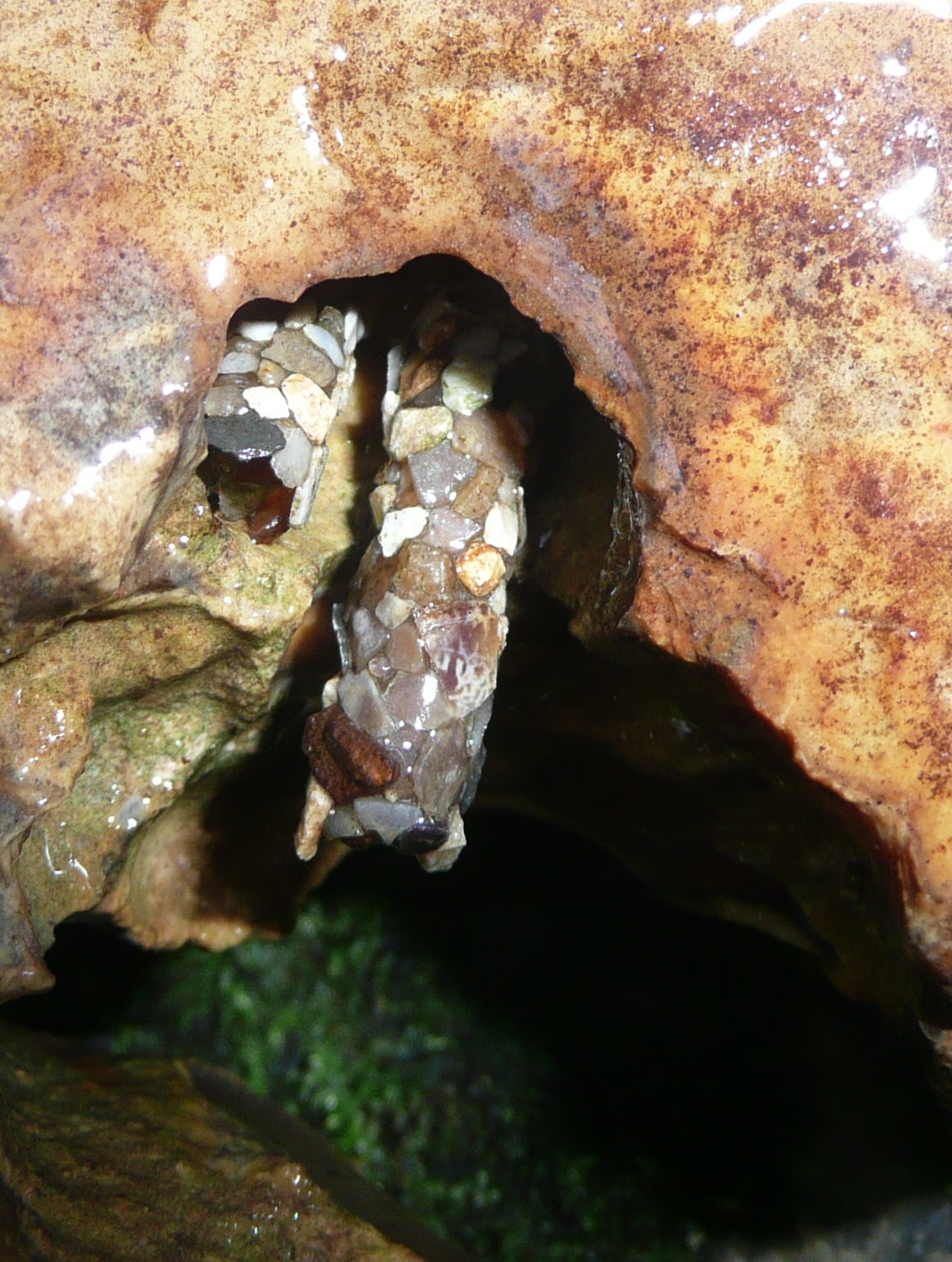 |
| Cadis Fly larvae. |
The group is in the process of purchasing a much better microscope with a Lottery Grant we have just been awarded which will allow us to be able to distinguish between different sub species much more clearly as well as allowing the children in the village to learn how to use good quality scientific equipment. We linked up with a local school at a stream dipping event in the summer of 2011 as part of a plan to extend our group's activities beyond the village.
We are now part of the national Riverfly recording scheme and carry out surveys monthly. if you wish to become involved with this contact Dave Emery.
Produced for the Sutton Poyntz Biodiversity Group by John Newbould.
The Basics
Mosses and liverworts are small plants, which collectively belong to a group known as BRYOPHYTES. These are seedless plants, split into three groups: hornworts (as far as we know, there are none in Sutton Poyntz), liverworts, which are fleshy and often found on trees and mosses. There are 1069 species in Great Britain and Ireland. These consist of four hornworts, 303 liverworts and 789 mosses. In or near to Sutton Poyntz, Humphrey Bowen in “The Flora of Dorset” reports 183 bryophytes having been recorded.
To identify these plants, one needs a spray bottle of water, a hand lens (x 10 to x 20) or a microscope for detailed features and the field guide Mosses and Liverworts of Britain and Ireland published by the British Bryological Society.
Mosses are effectively split into three groups; sphagnum or bog mosses are found on wet acid heaths and moors e.g. in Purbeck. The others are: Acrocarps - grow upright and have capsules at the top of their stems and Pleurocarps - form wefts or mats that spread horizontally with capsules arising from the sides of the main stems.
Liverworts There are two types of liverworts:
Leafy liverworts with a stem and leaves e.g Frullania dilatata (Dilated scalewort) which is common , especially in orchards (see picture below); and thallose liverworts with no distinct stem and leaves.
Mosses and liverworts may be found on trees, stones, walls, roofs, stream edges, in grass and even on roadside edges. They do not cause damage to trees or plants, getting their food from photosynthesis and collecting moisture from cracks. Generally, they require light and moisture.
For more information go to www.britishbryologicalsociety.org.uk
Examples of mosses and liverworts you may see walking round Sutton Poyntz:
Acrocarps – these examples were photographed on the foot bridge by the pond.
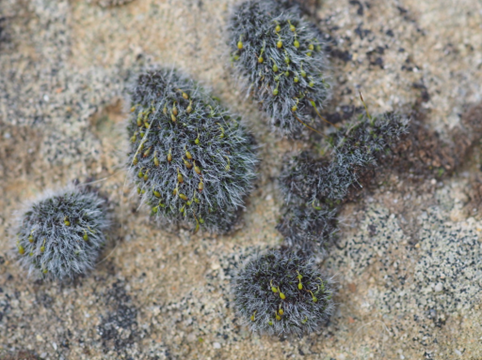 |
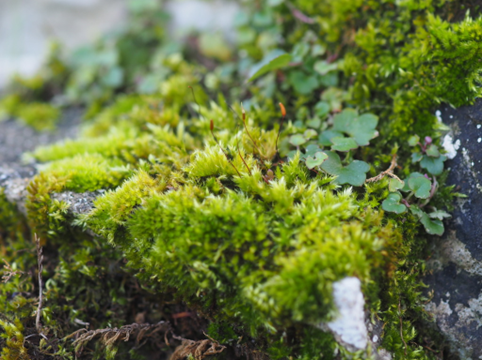 |
|
Grimmia pulvinate – Grey cushioned grimmia |
Didymodon vinealis Soft-tufted beard moss |
Pleurocarps
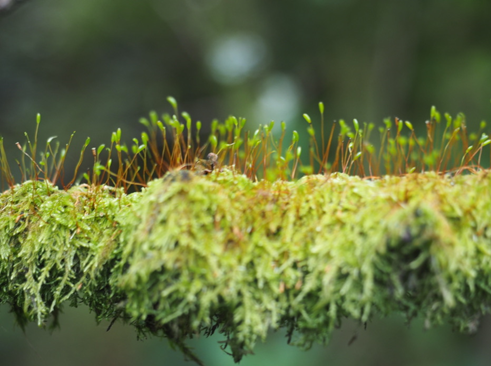 |
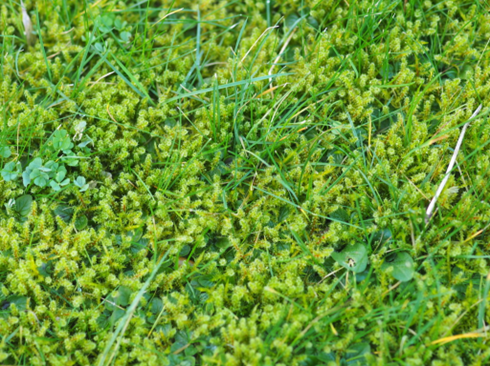 |
|
Hypnum cupressiforme Cypress-leaved plait-moss growing on hazel in wettish woodland.
|
Rhytidiadelphus squarrosus springy turf-moss growing in a Sutton Poyntz lawn. In fields, which have not been ploughed or had chemicals added, this is a good location to look for waxcap fungi. |
|
Liverworts: Leafy liverworts with a stem and leaves e.g Frullania dilatata Dilated scalewort (see opposite), which is common, especially in orchards and on smooth barked trees |
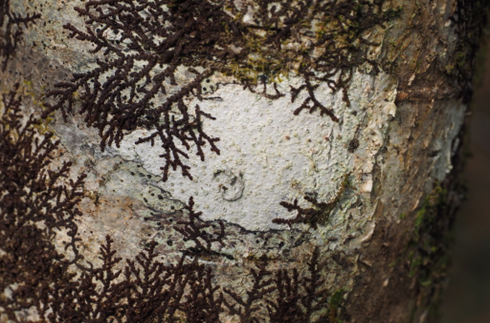 |
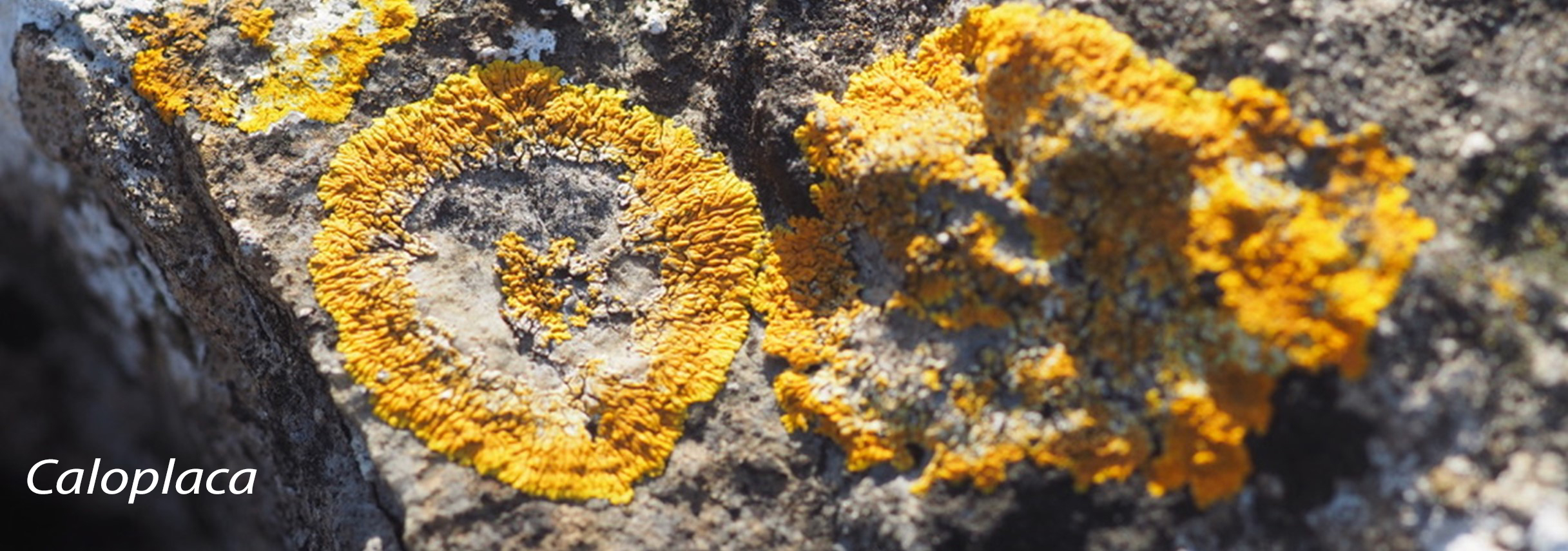
What is a lichen? “A lichen is not a single organism; it is a stable symbiotic association between a fungus and algae and/or cyanobacteria.” Britishlichensociety.org.uk
Where are lichens found? In very simple terms, lichens may be found on stone, brick, roof tiles, trees and wood with the species of lichen varying on the pH of the stone or bark. There are over 1800 species of lichen in Britain.
What do lichens look like? The banner photograph shows a crustose lichen. As the name suggests these form a crust on the substrate to which they are firmly attached.
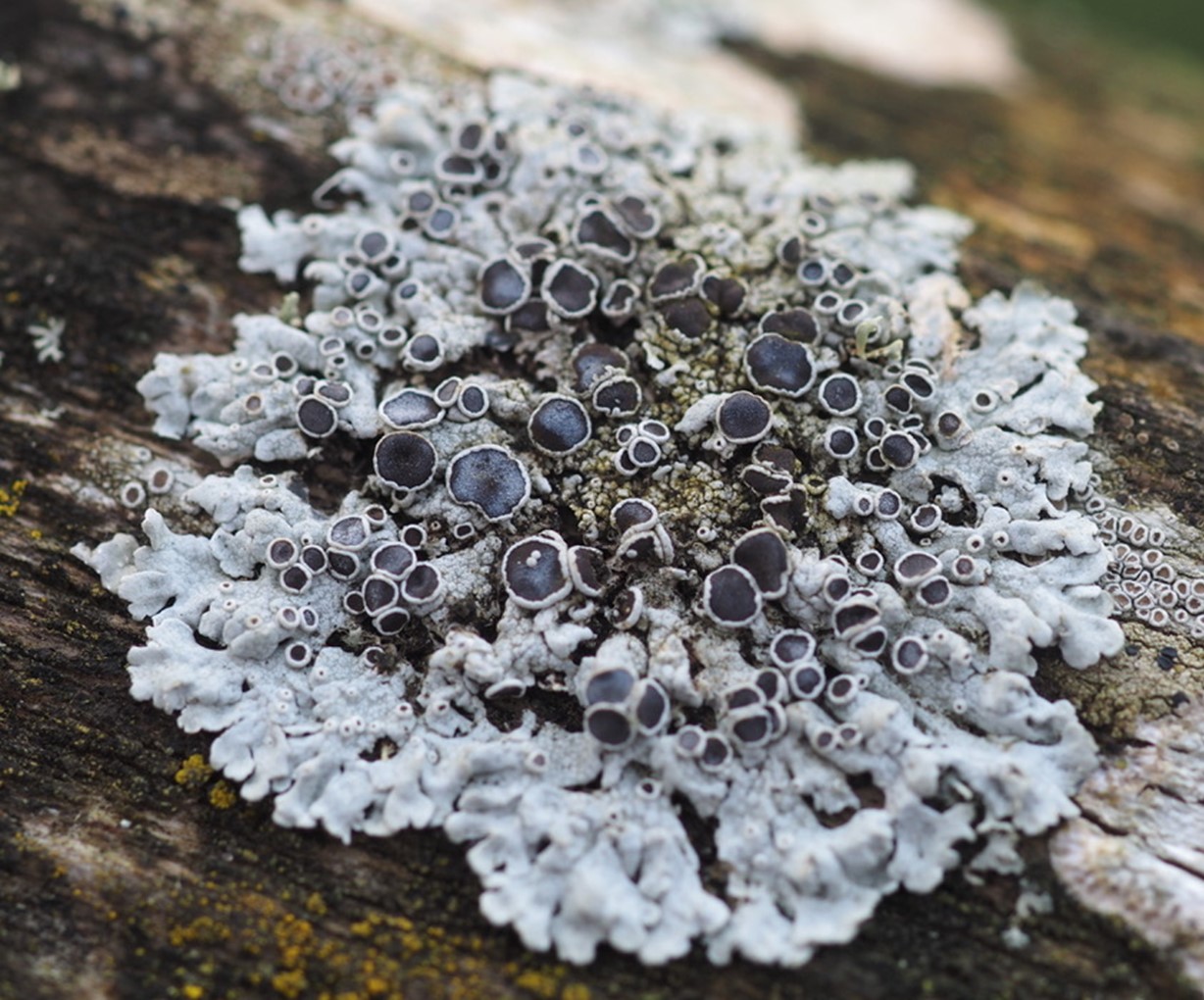 |
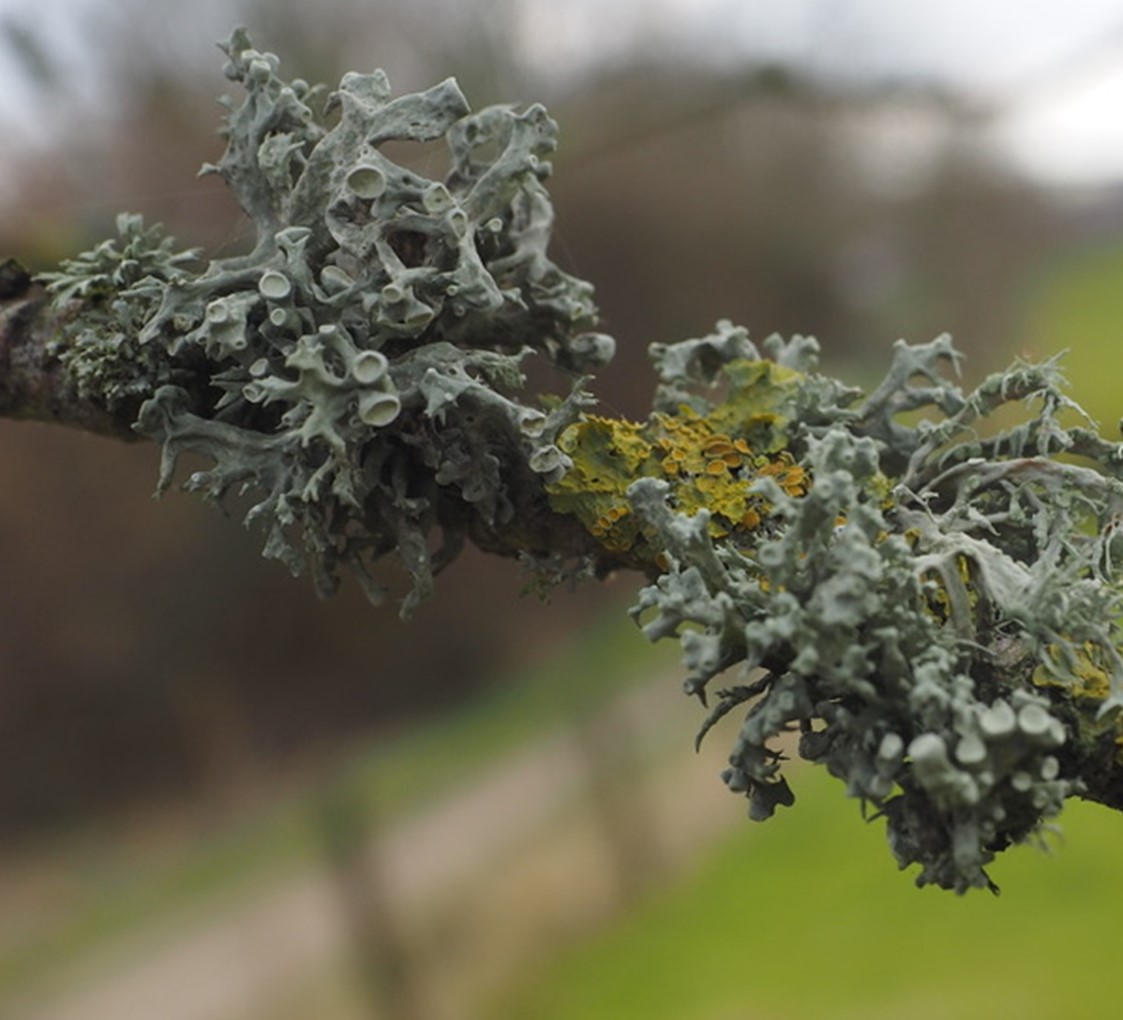 |
| Physcia aipolia is a foliose lichen | Ramalina fastigiata is a fruticose lichen |
Foliose lichens are leaf like and attached to the substrate from the lower surface at multiple points.
Fruiticose lichens are tree like and attached to the surface at a single point.
Are lichens harmful to our trees? No – they are very useful indicators of clean air and different lichens will have different tolerances to polluted air.
How do I start to identify lichens? Firstly, one needs a magnifying glass with x 10 and x 20 magnification. The Field Studies Council (field-studies-council.org) supplies some simple identification guides. The British Lichen Society sells Lichens - an illustrated guide to British and Irish Species. Both organisations offer on-line courses with the former making a charge.
A list of lichens so far recorded in and around Sutton Poyntz can be found in the Reports section. Click here to go to it.
If you think you may have discovered a new one or an existing one in a new location John Newbould is happy to help to confirm.

